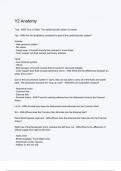Exam (elaborations)
Y2 Anatomy (1 Questions & 100% Verified Correct Answers with complete solutions (Latest update
- Course
- Y3M1 Osteopathic Theory
- Institution
- Y3M1 Osteopathic Theory
Y2 Anatomy (1 Questions & 100% Verified Correct Answers with complete solutions (Latest update
[Show more]



